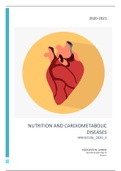Summary
Summary of the course Nutrition and Cardiometabolic Diseases (HNH32106_2020_2)
Summary of all the lectures, spoc modules, assignments, practicals and some readings of the course Nutrition and Cardiometabolic Diseases (HNH32106_2020_2). Including figures.
Update: including a hand-written summary at the end of the document
[Show more]
Last document update: 4 year ago
Preview 10 out of 128 pages
Uploaded on
December 1, 2020
File latest updated on
December 14, 2020
Number of pages
128
Written in
2020/2021
Type
Summary
cardiometabolic diseases
stroke
heart disease
embolism
diabetes
heart failure
tia
Institution
Wageningen University (WUR)
Education
Bachelor Voeding En Gezondheid
Course
Nutrition and Cardiometabolic Diseases (HNH32106)
All documents for this subject (1)
By: rkkmorren • 4 year ago
2020-2021




